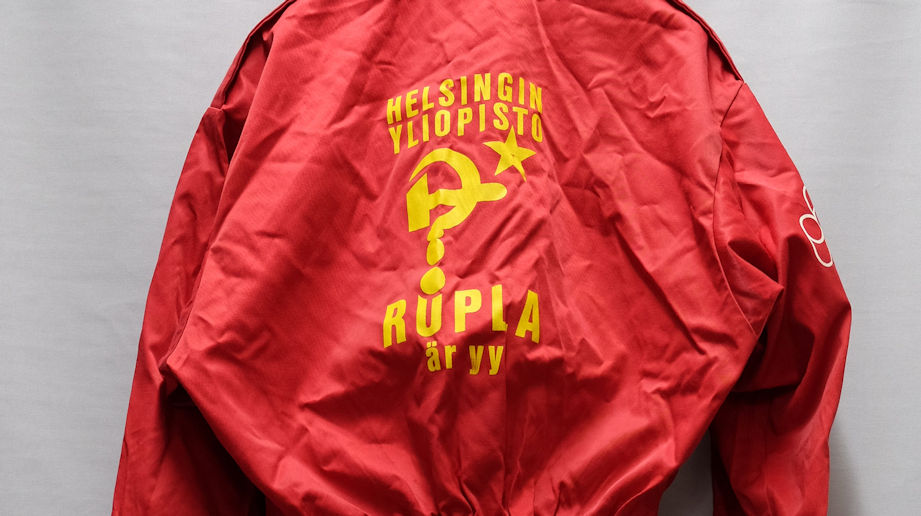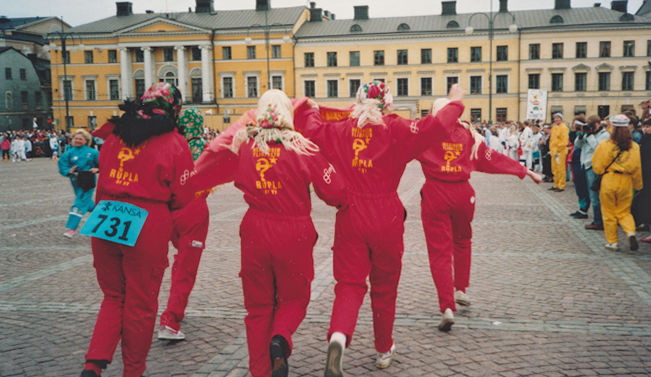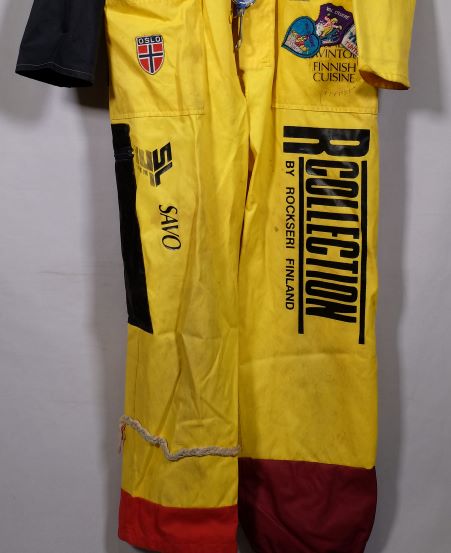It is August, and students admitted to Finnish institutions of higher education appear on the streets with peer tutors wearing their overalls. I donated my own pair of student overalls to the Helsinki University Museum in 2015 for the new main exhibition. It had been years since I had worn them, and whenever I had moved, I pondered whether to keep or donate them. Luckily, I had kept them, possibly in anticipation of a renovation or paint job that had never happened. The overalls, originally designed for Rupla, the association for students of Russian language and literature as well as Slavonic philology, were issued in November 1990. My pair was on display in the Power of Thought exhibition until August 2018.
Overalls for the Rupla association, at last!
Acquiring a pair of overalls was no easy task. Two energetic students of Russian, who had begun their studies in 1987, decided something had to be done after enduring three May Day celebrations wearing the ‘boring overalls designed for the University of Helsinki Student Union’. They did not hesitate to approach large companies to talk to those holding the purse strings. Usually, they were given just a phone number to call. The cost estimate for an order of 40 pairs of overalls was 10,000–12,000 Finnish markka, truly a tall order, as just two names were on the list of buyers in March 1990. However, the project moved forward, and by May, the number of buyers was already 13. The rank-and-file members of Rupla had a suspicious, if not surly, attitude towards the project.

Autumn came, and the committee in charge of the project put its faith in the freshers. It paid off, for soon 26 people had put their names on the list of buyers! A cheaper supplier was also found and the cost estimate was halved. Eventually, Neste Oy, the Finnish Paper Mills Association Finnpap and the Foundation for the Promotion of the Russian Language agreed to act as sponsors. Suddenly, there was enough money for an order of 30 pairs. However, there was still one problem: who could draw a printable picture for the back of the overalls? The topic – a hammer and a sickle – had been decided at a meeting of the overalls committee (accused by some as being of a wheeling and dealing kind), but no Rupla member had the skills necessary to draw the picture. Luckily, a board member stepped up to the plate and contacted an ex-boyfriend working at an ad agency, who agreed to create the picture using the agency’s equipment – and for no charge.
A common outfit contributes to a sense of community
The overalls were first worn during a volunteer cleaning day in the Lingva facilities of the organisations of language students of the New Student House. The overalls were then officially ‘inaugurated’ at a party held by a board member living in the Domus Academica (‘Domma’) student housing complex. The first public outing for the overalls was on May Day in 1991. Soon after, they made an appearance at the Academic Quarter student relay race, where student teams ran for 15 minutes from one end of Senate Square to the other, embracing the carnival spirit. During the next few May Day celebrations at Ullanlinnanmäki, the overalls kept students warm in the chilly spring weather. You could even hide a pair of long johns and a jumper underneath, and wear a wind-proof coat on top. However, the overalls proved highly impractical in one situation, namely, when answering the call of nature.

A few words on the history of student overalls
The first students in Finland to wear overalls were those studying at the Helsinki University of Technology. The overalls were in some cases boilersuits obtained from summer jobs or the sponsors of various events, and they were worn in various activities already in the 1960s, for example, in 1966 when the Helsinki University of Technology moved to the Dipoli building in the Otaniemi district of Espoo. The tradition had originally been established in Sweden, as had the student caps adopted by Finns 175 years earlier. In Sweden, university students of technology might have a pristine tailcoat for formal academic festivities and a slightly shabbier one for more boisterous parties. When student numbers increased, not all students were able to purchase two tailcoats, so they wore a lab coat or a boilersuit for informal parties. In Finland, the overalls worn by technology students’ guilds became more common as of the 1980s. At the University of Helsinki, overalls were first introduced in the 1980s at the student associations known as ‘student nations’ as well as at the Faculty of Medicine and the Faculty of Law. Many arts students long wore the overalls of their student nation or the Student Union because their own organisations were among the last to adopt the custom.
The Eteläsuomalainen osakunta nation as a pioneer
The Eteläsuomalainen osakunta (ESO) student nation was the first organisation within the University to launch its own official student overalls in the period from 1983 to 1985. This was a time of closer cooperation between ESO and the Helsinki University of Technology, and ESO accepted as external members technology students, who were already familiar with the custom of wearing student overalls at parties. However, a photograph from 1979 reveals that some male members of ESO wore a blue-grey boilersuit and a student cap at the nation’s first event involving the collective washing of the statue of the writer Aleksis Kivi. It is possible that this was due to practical reasons as the boilersuit protected their clothes from splashes, and it may also have been based on the example set by the technology students.
When acquiring overalls, it is important to ensure that the logo, symbols and colours are based on those of the relevant organisation or discipline. For example, the ESO overalls are orange, which is one of the two colours (alongside white) on ESO’s official sash, and the organisation’s name and symbol are printed on the back. Overalls thus developed into a means of standing out from among other student groups, while also serving as group emblems. Colours and symbols as well as the patches that later became common tell other students who the person is, which events he or she has attended and, of course, which companies have sponsored the overalls.

The first orange pairs of ESO overalls were of regular soft cotton, but the more water-resistant Enstex fabric was used for the material as of spring 1988. A former ESO member reminisces: “First of all, the overalls were worn during the herring breakfasts that followed major parties, such as the student nation’s annual celebration, as well as at less formal outdoor events for the student nation members: during the May Day festivities together with the student cap, on Shrove Tuesday when sledging in Kaivopuisto, at the Academic Quarter, in the academic world championships in Finnish skittles and in similar competitions between student organisations as well as when serving as officials in, say, freshers’ relay races or similar events in Helsinki. The overalls were also worn every spring when washing the statue of Aleksis Kivi. In the late 1980s, we were still allowed to climb on the statue, so we scrubbed Aleksis up nicely, and the whole thing ended with the statue being hosed down by a fire engine.”
The Rupla overalls as an object
The overalls I donated to the Helsinki University Museum had been made by a company called Luca. The material used is Enstex, a blend of polyester and cotton. Printed on the back are the names of the association and the University of Helsinki as well as a yellow-orange depiction of the symbols of the Soviet Union, with the sickle drawn in the form of a question mark. Printed on the front of the thigh area is the word Rupla (‘Ruble’) in yellow letters. The logos and other marks are those of the companies that sponsored the purchase of the overalls. Pinned in the chest area is a matryoshka doll, which was gifted to me by a student representing Moscow State University. Each year, the University of Helsinki Student Union invited students from Moscow State University (MGU) for a visit, and the Rupla association hosted the visitors, organising parties and excursions. The overalls also feature an Einstein badge and a silver bear pin. I have no recollection of where they came from.
My overalls have none of the patches that have since become popular with students, particularly in the 2000s. But we did buy badges, medals and pins for our overalls from flea markets, for instance.
Phenomena related to student overalls
These days, students from universities of applied sciences also wear overalls, and the colours of the overalls do not necessarily reveal the person’s subject or student nation, as they did in the early 1990s. However, certain student nations can still be distinguished by their overalls. For example, Vasa Nation has overalls with diagonal stripes based on the student nation’s sash, while the overalls of the Hämäläinen osakunta student nation have red and white stripes. Burgundy is the colour of law students, and purple that of theology students.
Exchanging the trouser legs of overalls with representatives of other student organisations became increasingly common in the 1990s. A trouser leg with a different colour could be a great souvenir from a student event: students cut off a piece of their trouser leg and exchanged it with another student who had cut off a piece from about the same height. The trouser legs could be reattached on the spot, for instance with safety pins, and properly sewn on later. Nowadays, students often wear their overalls half way down, with the sleeves tied around the waist. This was not done in the 1980s and 1990s, except in extremely warm weather.

A unique pair of overalls can also be created by splitting two pairs and then joining together two halves of different colours. This may mean that the owner has changed subjects, cut both pairs of overalls into two pieces and then sewn two halves together. Some organisations, such as the Limes organisation of students at the Faculty of Science, have acquired capes rather than overalls, while some students, such as an archaeology student in the 2010s, have themselves refashioned their overalls into capes. However, even though I later changed my subject to art history, I did not consider it necessary to obtain a new pair of overalls.
The Helsinki University Museum’s collection contains a total of 12 pairs of student overalls, but information on their original context is deficient. If you have worn any of the models in our collection, we would be very interested in receiving more information on their purchase and wear. Our collection includes not only the Rupla and ESO overalls, but also those worn by chemistry, geology, environmental science and theology students as well as by members of the Keskisuomalainen, Hämäläinen, Savolainen, Etelä-Pohjalainen, Pohjois-Pohjalainen and Satakuntalainen osakunta student nations. Our main exhibition currently includes a pair of overalls designed for the Kronos association of history students, on loan from a private individual.
Pia Vuorikoski
Head of exhibitions
Translation: University of Helsinki Language Services.
Sources:
Interview with Matti Änkö in the Yle radio programme Aristoteleen kantapää, 29 April 2015
Poutiainen, Heli: Haalarien historia. Kopeekka 1/1991.
